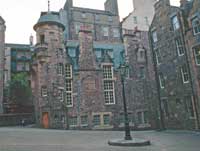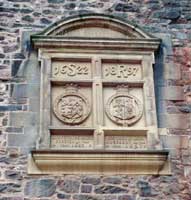Countess of Stair - All manner of Glass?
The Edinburgh Stairs and closes used to be named after the principal inhabitants, and Lady Stair’s Close was originally called Lady Grey’s Close after the wife of the builder of the house. Their initials are above the doorway with the date 1622. The name changed to Lady Stair at the beginning of the 18 th century. The house was restored in 1897 by the Roseberry’s (Primrose’s) and the initial SR on wall marks this. (Stair Roseberry) - to atone for the past?
 Lady Eleanor Campbell was the granddaughter of Chancellor Earl of Loudon, a covenenter who met an early death at the hands of Charles I. She was renowned to be of robust constitution but was no match for James Viscount Primrose, to whom she was married. He treated her barbarously. The marriage ended to all intents and purposes one day, when she saw reflected in her mirror, her husband coming into the room sword in hand. She jumped from the window and ran to her mother-in-law’s house and demanded protection. This was granted and they never lived together again.
Lady Eleanor Campbell was the granddaughter of Chancellor Earl of Loudon, a covenenter who met an early death at the hands of Charles I. She was renowned to be of robust constitution but was no match for James Viscount Primrose, to whom she was married. He treated her barbarously. The marriage ended to all intents and purposes one day, when she saw reflected in her mirror, her husband coming into the room sword in hand. She jumped from the window and ran to her mother-in-law’s house and demanded protection. This was granted and they never lived together again.
Lord Primrose went abroad. While he was away Lady P went to a fortune teller to enquire after him. The physic showed her an image in her mirror. It was of an inside of a church with a marriage party at the alter. She thought that the groom looked like Lord P. The priest had just started the ceremony when a latecomer arrived who looked like Lady P’s brother (who also happened to be abroad). On getting to the front, the latecomer’s face changed, he drew his sword and rushed at the groom. The image then faded. Lady P was affected by this, wrote it down, dated it and put it in a sealed envelope.
 When her brother returned, Lady P quizzed him. He had become aquatinted with a Dutch merchant who had a beautiful daughter. Her was invited to her wedding to a ‘Scottish gentleman who came to reside there’. He had arrived late, but in time to save the bride from his own brother in law, Lord P. The date was the same that Lady P had visited the fortune teller. She showed her brother the notes in the envelope.
When her brother returned, Lady P quizzed him. He had become aquatinted with a Dutch merchant who had a beautiful daughter. Her was invited to her wedding to a ‘Scottish gentleman who came to reside there’. He had arrived late, but in time to save the bride from his own brother in law, Lord P. The date was the same that Lady P had visited the fortune teller. She showed her brother the notes in the envelope.
Lord Primrose died in 1706 leaving a young widow who could hardly be expected to mourn his passing. Unsurprisingly she resolved never to marry again.
However Lord Stair came to court her and realising her would get nowhere, resorted to trickery to gain her hand. He bribed a servant to gain entry and then displayed himself scantily clad at a window early in the morning for the populace to see. Lady P then felt obliged to marry him in order to keep her reputation from being torn to shreds. (1708)
Unfortunately for Lady Stair, Lord Stair was also violent after drinking too much. After one bout he bloodied her face. Lady Stair decided not to clean the wound but let the blood run and stayed where he slept. When he awoke, he was so ashamed of what he had done, that he vowed that he would only drink what she had first passed to him. He kept the promise for the rest of his life.
Source - Traditions of Edinburgh by Robert Chambers
link to this story in this history of the Lawnmarket.
